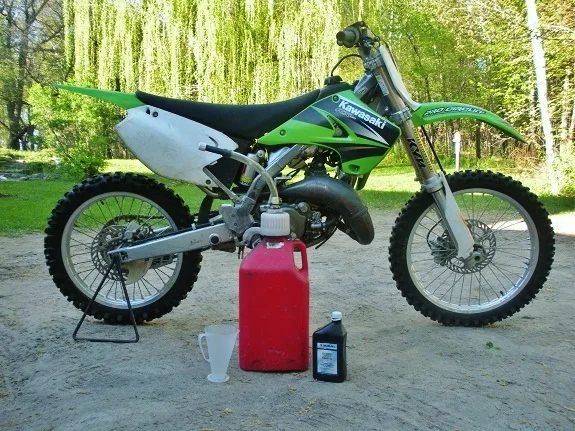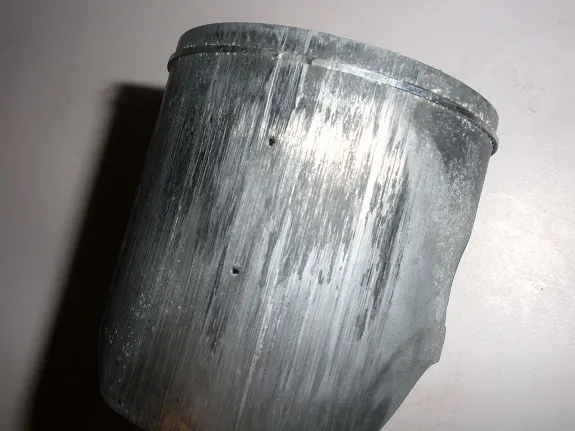Trying to decide if you should buy a dirt bike with oil injection or premix but not sure which is better? The truth is, they can both work great, but you really need to understand how each system works to know which is best for you.
In this article, you’re going to learn what premixing gas and oil injection actually is, why you may not want each one, and then how to pick the right option based on your specific needs.
What is premix?
Premix is simply when you mix gas and 2-stroke oil together before you put it into the gas tank of your dirt bike. For example, some common 2 stroke oil mix ratios are 32:1 and 50:1, meaning that for every 32 or 50 ounces of gas, there’s 1 ounce of oil.

Why do 2 strokes need premix?
Unlike 4 stroke dirt bike engines that keep the same oil contained in the crankcase, 2 stroke dirt bike engines require premixed gas for lubrication. The oil in the premix lubricates the bottom-end crankshaft and top-end cylinder.
What happens if you don’t use premix in a 2 stroke?
For example, if you use straight gas (no oil), the engine will seize within minutes because it will overheat from excessive friction. Once it gets too hot for too long, the internal engine parts will start to melt and essentially “weld themselves together”, causing an engine seizure - AKA a blown engine.

Is premix better than injector oil?
If you’re trying to compare 2 stroke oil vs 2 stroke injector oil, they’re essentially the same thing, but it also depends on their specs and the application that they’re intended for. Basically, you should choose a 2 stroke premix/injector oil based on your type of engine and how you are going to use it, such as Amsoil Dominator (check price on Amazon) for racing at high RPM
For example, you don’t want to use injector oil that’s made for a low RPM recreational engine in your high-performance race bike that will be at high RPM most of the time. The oil won’t be able to sufficiently lubricate the engine parts and will most likely cause excessive wear on the piston, rings, and crank.
![2 Stroke Oil Comparison Oil Injection or Premix Dirt Bike [Which To AVOID?]](https://motocrosshideout.com/wp-content/uploads/2023/09/2-Stroke-Oil-Comparison-1200x675.jpg.webp)
What is oil injection?
Oil injection is a system that injects and mixes oil into the gas as it’s going into the engine, as opposed to a premix system where you mix the oil and gas by hand before pouring it into the gas tank.
How does oil injection work?
An oil injection system on a 2 stroke dirt bike pumps oil from a separate tank into the carb and mixes it with gas while the engine is running. Many oil injector systems change the mixture ratio depending on the throttle position.
In other words, at idle, the oil mix ratio can be set at 100:1, but at full throttle, it’s at 20:1. This means that there is 5 times more oil being pumped into the gas mixture in this example.
Why does the oil mix ratio change based on throttle position?
At idle, there is not much friction between the engine parts, so less oil is needed. As the engine RPM increases, friction and heat increase, requiring more oil to lubricate and keep the parts at proper operating temps.
![ERX 6 13 09 Oil Injection or Premix Dirt Bike [Which To AVOID?]](https://motocrosshideout.com/wp-content/uploads/2020/03/ERX-6-13-09.jpg.webp)
This is why smaller 2 stroke race engines generally need a higher oil ratio because they need to be ridden at a higher RPM to keep it in the “meat of the power” (AKA powerband).
Is oil injection 2 stroke or 4 stroke?
Oil injection is only for 2-stroke engines on a dirt bike for one simple reason - a 4 stroke doesn’t need oil in the gas to lubricate the engine. With that said, it generally won’t hurt if you add a very small amount of 2-stroke oil to the gas tank of your 4 stroke dirt bike.
Some people add 1 ounce for every 1-2 gallons (between 100:1 & 200:1 ratio) to lubricate the valves and piston assembly, but it’s not necessary.
Oil injection vs fuel injection - what’s the difference?
There is a huge difference because they’re not even comparing similar systems. Here’s the difference between oil and fuel injection:
Oil injection:
- Injects oil into the gas mixture
- The oil lubricates the engine on a 2 stroke dirt bike
- Does NOT control the fuel system
Fuel injection:
- Is the fuel system that controls how much gas is injected into the engine
- Fuel injection takes the place of a carburetor and determines the air-fuel mixture
- A 2 stroke can have a fuel injected system and an oil injection system to control both the fuel and oil being injected into the engine
![2018 KTM TPI Fuel Injection Throttle Body Oil Injection or Premix Dirt Bike [Which To AVOID?]](https://motocrosshideout.com/wp-content/uploads/2023/09/2018-KTM-TPI-Fuel-Injection-Throttle-Body.jpg.webp)
Can you trust an oil injected dirt bike to be reliable?
Maybe you’re worried about the oil-injection system failing and the engine seizing - I totally understand your concern because you don’t want your dirt bike to break down miles from camp.
However, dirt bike manufacturers do a lot of reliability testing before releasing bikes for sale to the public. This means that you’re not likely to have a problem because oil injected systems are typically very reliable if you take care of your 2 stroke dirt bike.
Why do people remove the oil-injection system?
Some people don’t like “change” and since they heard about 1 guy on the internet that had their oil injection fail, they don’t want to deal with it and so they remove it and go back to premix only.
While there are some benefits to pre-mixing your gas and oil, the benefits of oil-injection might outweigh the drawbacks, which we’ll cover next..
Oil injection vs premix - which is best for you?
Alright, if you’re still confused or just not sure if you should look for and buy a 2 stroke dirt bike with oil-injection or premix only, it’s time to weigh the practical pros and cons of each system.
Oil injection pros:
- No mixing gas
- Easy to re-fill at a gas station on long rides
- Can go through 2-3 gas tanks of riding before needing to refill the oil tank
- Automatically controls the oil ratio - No guessing or accidentally forgetting what’s in your gas can or tank
- No need to have separate “Pre-mix” gas cans - use the same can as 4-strokes to re-fuel
- uses less oil overall
- Generally less smoke & spooge out of the exhaust
Oil injection Cons:
- Engine can seize if the Oil Injection system fails
- Engine can seize if the oil tank runs dry
- Can cause plug fouling due to poor oil injector tuning
Premix Pros:
- You have control of the oil mix ratio
- Less moving parts to fail
- No oil tank to worry about re-filling
Premix Cons:
- Mixing gas by hand - takes longer and can be messy
- Only 1 ratio - uses the same gas:oil ratio at idle or full throttle
- Harder to refill at a gas station because you need to bring the right amount of oil in a separate bottle - also harder to mix
What dirt bikes are premix only?
Almost all 2 stroke dirt bikes 20 years ago you had to premix, but a lot of models are moving away from it for a good reason - it’s less of a hassle.
Here are some popular dirt bikes that are still pre-mix only:
- KTM 65SX
- Kawasaki KX85
- Yamaha YZ125
- Kawasaki KDX200
- Yamaha YZ250
![2021 Yamaha YZ125X 1 Oil Injection or Premix Dirt Bike [Which To AVOID?]](https://motocrosshideout.com/wp-content/uploads/2023/04/2021-Yamaha-YZ125X-1-1200x675.jpg.webp)
What dirt bikes have oil injection?
Some dirt bikes have had it forever (PW50), but some off-road brands like Beta and KTM have heavily switched over in the past decade.
Here are some popular 2 strokes with oil injection today:
- Yamaha PW50
- KTM 250XCW
- Beta Xtrainer 300
- Beta 200RR
![2024 Beta CrossTrainer 300 Oil Injection or Premix Dirt Bike [Which To AVOID?]](https://motocrosshideout.com/wp-content/uploads/2023/09/2024-Beta-CrossTrainer-300-1200x675.jpg.webp)
Tips for premix & oil injection systems to stay reliable
No system is perfect, but sometimes it’s just “user error”, whether you’re negligent or you just don’t have the knowledge and experience. What do I mean by that?
Sometimes it’s just the things we forget to do or don’t know to do that cause our dirt bike problems. Over the years I’ve learned some simple hacks that make my dirt bikes more reliable, so here are some things you can do to make your 2 stroke dirt bike last longer:
- Use fresh gas - gas brakes down in a matter of weeks, causing your bike to not run well or “gum” up the carb/fuel system
- Add oil before gas into premix - Oil mixes better if you pour in the gas after the oil
- Shake the can/tank before pouring/turning on the gas - Some oils separate from the gas, so I make a habit of “premixing” again every time I use it
How to make your dirt bike last longer
Besides the tips above, there are other really easy ways to make your dirt bike last 2-3 times longer before needing a rebuild. Want to learn how with a simple checklist? Tap here to grab it today for FREE.

